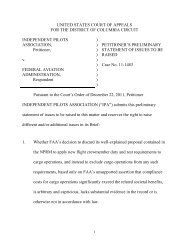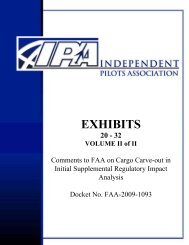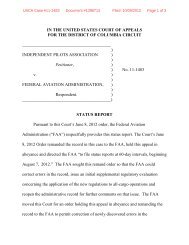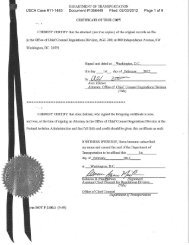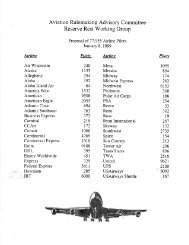Submission - Independent Pilots Association
Submission - Independent Pilots Association
Submission - Independent Pilots Association
You also want an ePaper? Increase the reach of your titles
YUMPU automatically turns print PDFs into web optimized ePapers that Google loves.
1) For typical flights from the U.S. to Europe or Pacific destinations, the number of timezones crews would transit would be in excess of 5 or more. The general agreed upon acclimationrate is about 1 time zone or one hour difference per day. 26Some expert researchers havepublished data showing even longer periods to become acclimated to the local time zone. 27Conclusion: The crew would not be acclimated after 36 hours of layover rest.2) While 3 consecutive physiological nights may start approaching a reasonablecompromise for the purpose of entering the FDP tables, a 36 hour rest by itself clearly would not.In order for the rules to approach parity, the implication is that a night of normal sleep would beapproximately 8-9 hours of sleep. Three nights of consecutive sleep would be 24-27 hours ofsleep. The 36 hour rule suggests that crews would remain asleep for nearly the entire layoverperiod. This is not physiologically plausible for healthy aircrews.3) Further, when crews are put into a rest period, it is critical for any fatigue safetyregulation to assess where they are in their own circadian cycle – as that will determine when inthe following rest periods, crews would be able and likely to sleep from a physiologicalperspective. To be sure, being put into a rest cycle does not mean that the crew will be able to26 It takes about one day for every time zone crossed to recover from jet lag. When circadian disruptionand sleep loss occur together, the adverse effects of each are compounded.Battelle Memorial Institute. March 1998. A Review of Issues Concerning Duty Period Limitations,Flight Time Limitations, and Rest Requirements as stated in the FAA’s Notice of Proposed Rulemaking95-18, 60 Fed. Reg. 244 (Proposed Dec. 20, 1995).27 For example: Gander, et al. (1989) showed that it took several days for the acrophase of the temperaturerhythm to come within one standard error of complete resynchronization after a 9h westward transition,and that the adaptation in an eastward direction took even longer. Paper presented at the RTO HFMLecture Series on “Sleep/Wakefulness Management in Continuous/ Sustained Operations,” held in FortRucker, Alabama, United States, 17-18 June 2002; Warsaw, Poland, 24-25 June 2002; Paris, France, 27-28 June 2002, and published in RTO-EN-016, Gander PH, Myhre G, Graeber RC, Andersen HT, LauberJK (1989) Aviat Space Environ Med 61: 733-743.62



